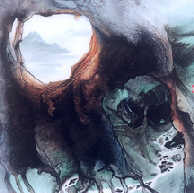 The disadvantage is that since a kiln is not used to permanently fuse the paint to the glass, paints made for other surfaces have a tendency to peel or chip when used on glass.
The disadvantage is that since a kiln is not used to permanently fuse the paint to the glass, paints made for other surfaces have a tendency to peel or chip when used on glass.
To counteract this tendency and increase the life span of the paint, you should concentrate on thoroughly preparing the surface of the surface of the glass. Sandblast if at all possible. At a minimum, rough the surface up with wet/dry sandpaper. Roughing the surface in this manner will help the paint adhere better and last longer. Applying the paint with an airbrush, rather than by hand, also tends to yield better results.
 Air-dried and oven-cured glass paints
Air-dried and oven-cured glass paints
In this approach, the painter starts with a clear sheet of glass, then colors the glass in a pattern that approximates "real" stained glass. Sometimes practitioners of this style even go so far as to apply paste outlines designed to resemble stained glass lead or solder lines. In general, people who make stained glass frown upon this style of glass painting.
These paints do, however, have the advantage of being specially formulated for painting on glass. They come in two varieties: air-dried and oven cured.
As the names suggest, air-dried glass paints are simply applied and then allowed to dry (drying takes about eight hours). These paints are most suitable for decorative purposes on surfaces that will not be handled much. In most cases they can withstand only light washing in cold water, and are not suitable for food-bearing surfaces or items that will be handled.
Oven cured paints are a bit more durable. They require the use of a conventional kitchen oven to heat the glass to around 300 to 400 degrees Fahrenheit. This is hot enough to help bond the paint to the glass and will adhere better than glass that isn't heat-set at all, but the temperature isn't hot enough to fuse permanently.
 Glass enamels
Glass enamels
Although traditional painting on stained glass is probably the most common way of painting on glass, painting with glass enamels has grown significantly in popularity in the last few years. The range of colors is extensive, and the ability to mix colors means that a virtually unlimited palette is available.
